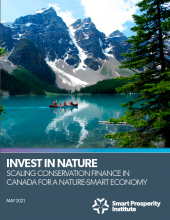Canada’s natural assets are globally significant in addressing the twin challenges of biodiversity loss and climate change. Healthy natural environments provide a range of social, environmental, and economic benefits to communities. Both the public and private sector are making significant commitments to nature, and yet despite the range of potential benefits, we have not seen investment at the scale that is needed. In this report we examine the Canadian conservation finance context across protected and conserved areas, forestry, agriculture, and ecological restoration, and provide pathways to overcome barriers and catalyze growth.
Key Messages
1. Scaling investment in nature is critical for the Canadian economy, to address climate change, and support the well-being of all Canadians. Natural systems contribute directly to 12% of the GDP via forestry, oceans, and agriculture. Conserving and restoring nature supports health and biodiversity, and can save billions by reducing the impact of, and adaptation to, climate change.
2. There is a global biodiversity finance gap, and it cannot be overcome by public finance alone. The global shortfall is estimated at US$700 billion annually between now and 2030. While core public funding is essential and can leverage both private and philanthropic dollars, scaling private investment will be needed to meet biodiversity and climate targets.
3. Attracting private finance to nature is challenging, given that ecosystems do not lend themselves to traditional investment vehicles. Nature often requires sizable upfront investments for benefits that accrue over time, diffusely or indirectly, and often in the form of avoided future costs that are not accounted for on balance sheets.
4. Conservation finance mechanisms help capture nature’s many value streams and bring new funders to the table. These financial instruments seek to generate financial, environmental and/or social returns. Scaling them requires overcoming complexity and risk.
5. The business case for investment is most easily made where revenue streams already exist, or cost savings are clear and easily quantified. More complex arrangements that capture environmental externalities and ecosystem benefits that are harder to measure involve multiple partners and increase transaction costs.
6. High transaction costs are a major impediment to developing a project pipeline in Canada. Overcoming this challenge requires :
- Establishing credible metrics and impact assessment methods. Improving the ability to estimate and track financial risk and ecosystem value streams is critical for conservation finance to connect with mainstream finance.
- Normalizing natural asset management and ecosystem service data collection. Governments can support and accelerate private-sector standards while promoting open access to ecosystem data.
- Creating an enabling policy environment. Programs to provide seed funding and matching funds, a clear regulatory environment, and favorable tax policies can all de-risk entry to investors.
7. Intermediaries are essential. Since there are often multiple partners involved, organizations are needed to design financial instruments, bring stakeholders together, and assess impact metrics that provide confidence to investors and accelerate implementation.
8. The landscape is diverse and collaboration is key. Stakeholders include Indigenous governments, agricultural communities, forestry, and heavy industry such as the oil and gas sectors, as well as banks, philanthropic organizations, and municipalities. The range of beneficiaries and investors may not be the same for a given project and development of collaborations, partnerships, internal, and external learning opportunities and professional development are needed.
9. Conservation finance solutions do not apply everywhere. Specific needs must be examined to evaluate the applicability of various financial instruments on a case-by-case basis. Efficiently allocating capital from new sources can free up donor funding for ecologically significant areas where revenue-generating and no-cost models do not apply.
10. Existing tools are not exhaustive. There is a need and opportunity to investigate new financing models that address Canadian challenges. Many carbon-rich and biodiverse landscapes are not currently at risk of conversion. This lack of “additionality” means they are not eligible for offsets - we need other financial incentives to reward protection and stewardship in these settings.



